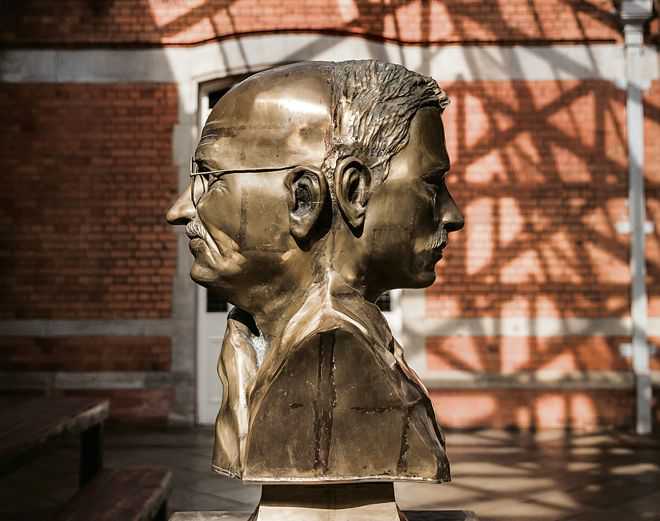
African connect: Gandhi’s two-sided bust at the Pietermaritzburg railway station.
Rahul Singh
Veteran journalist
I am sure readers have been overwhelmed by a surfeit of print and online matter on Mahatma Gandhi. But there won’t be many true anecdotes on the great man.
My first one is based on my own research. Just before Richard Attenborough’s wonderful film Gandhi was released — it went on to win eight Oscars — I was commissioned to do an article on its making by Reader’s Digest. Among those I interviewed was John Briley, who wrote its screenplay (he won an Oscar for it). He related how he had given his handwritten manuscript to his secretary to type it out. When it was returned to him, it had smudged splotches on several pages.
“What is this?” asked Briley. An embarrassed secretary replied, “I’m sorry, sir, they were my tears — I could not help crying over some passages.” Those who have been similarly moved by Briley’s magnificent screenplay will empathise with her.
While getting the material for the article on Attenborough’s film, a thought struck me: Wasn’t it strange — and also marvellous — that all those who came into contact with Gandhi and his teachings were somehow uplifted and changed for the better? Attenborough told me how obsessed he had been for a long time over making a film on the great man. Nobody would finance him, but he pursued the idea for years in the teeth of opposition from Indian film directors and producers, who said, “How can a foreigner make a film on the Father of our Nation?” Or words to that effect. It was thanks to Attenborough’s friendship with Jawaharlal Nehru, and then Indira Gandhi, that he got the go-ahead. He made other good films, but none as memorable as Gandhi. The Mahatma, in a profound sense, made Attenborough and Briley outreach themselves, the latter writing the best screenplay of his life. Gandhi transmitted something of himself to both men.
Here, let me record another ‘foreigner’, a Frenchman who, too, surpassed his own very exacting standards to write the finest — and bestselling — book on the Indian independence movement, Freedom at Midnight. Dominique Lapierre co-authored it with the American journalist, Larry Collins, but it had Lapierre’s unmistakable stamp on it. Though the book is entirely historical and based on painstaking research, it reads like fiction and is unputdownable. I got to know Dominique quite well (we played tennis at the Bombay Gymkhana Club), because Reader’s Digest condensed Freedom at Midnight in its book section.
Like Attenborough’s film, Freedom at Midnight also had its Indian ‘nationalist’ detractors. One well-known critic pointed out an incident in it of how Nathuram Godse, Gandhi’s killer, had got to know a woman on a plane to Delhi, and that he slept with her just before the assassination. ‘Fiction!’ howled the critic. Lapierre later told me smilingly, “He obviously did not examine the Delhi police records, which I did — it’s all there, in those records!”
I believe Attenborough’s Gandhi and Lapierre & Collins’ Freedom at Midnight brought the Mahatma alive in the minds and consciousness of more people worldwide than any other two works. And these were the creations of ‘foreigners’, though they were more ‘Indian’ than many of us. Lapierre became a great admirer of India and went on to write a book on Calcutta, City of Joy. Among his fans was famous industrialist JRD Tata, who spoke French fluently. Once at a dinner party at the Bombay Gymkhana, hosted by Lapierre’s publisher, Tata turned up. He told me he rarely went to such parties, but he had come because of Lapierre’s ‘genuine love for India’. Rare praise from a great man.
The next two anecdotes show Gandhi’s down-to-earth practicality. Once, when he was boarding a train that had already started moving, one of his chappals fell on to the platform. He quickly took off the other chappal and threw it in the direction of the first one.
“Why on earth did you do that?” asked an astonished passenger. “What use is one chappal to me?” replied the Mahatma. “The person who finds the first chappal may also find the second.”
On another occasion, he was asked to lay the foundation stone of a project. He declined, saying that he would be happy to come when the project was completed, not for its inauguration!
But my favourite is from what I consider the most readable book on Gandhi and his philosophy, by American journalist-turned-academic Louis Fischer. He relates the interaction between then South African Prime Minister, General (later Field Marshal) Jan Smuts, and Gandhi. This was during Gandhi’s long stay in South Africa, where he honed his philosophy of satyagraha and non-violence. Both men were political foes, with Smuts sending Gandhi for long periods in prison. Yet, they had a strange, sneaking admiration for each other.
On one of Gandhi’s stints in prison, he fashioned a pair of sandals and sent these as a gift to Smuts. When Gandhi was finally leaving South Africa for India, he found a packet in the cabin of his ship. It was from Smuts and inside were the same, but worn-out, sandals. The note from Smuts to Gandhi read: “I have worn these sandals for many a summer, even though I may feel I am not worthy to stand in the shoes of so great a man… it was my fate to be the antagonist of a man for whom, even then, I had the highest respect.”
A replica of those sandals now lies in a museum in Johannesburg. In London’s Parliament Square, there is a statue of Smuts. Facing him is a statue of Gandhi, a befitting recognition of two great, contrasting men, yet who respected and admired each other.



























